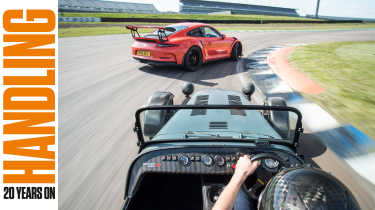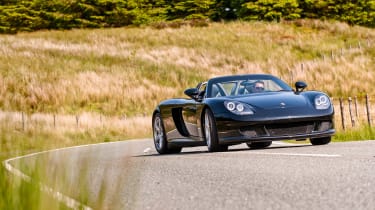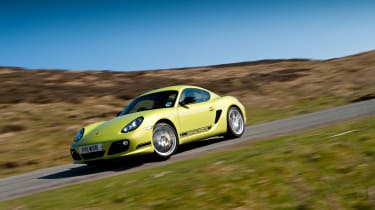Car handling explained: the past, present and future
Two decades after evo first quizzed the automotive industry’s leading engineers about what makes a great-handling car, we ask the question today to see what’s changed
Twenty one years ago, in the very first issue of evo, we ran a feature titled ‘What makes a great-handling car?’ It served a number of purposes. The cover car for that issue was the new Maserati 3200GT, but we had considered a multi-car story featuring some of our favourite models, from supermini to supercar, to help illustrate the scope of the magazine – what it was all about. In a way, ‘What makes a great-handling car?’ did that and also helped explain the meaning of our strapline – The Thrill of Driving.
We profiled a number of engineers who had helped create the dynamic character of some of our favourite cars and asked a series of questions we hoped would give us an insight into the making of a great-handling car. Among our interviewees were Gordon Murray of McLaren, Mike Cross of Jaguar, Roger Becker of Lotus, and Dirk Schoysman, who helped develop the Nissan Skyline GT-R.
Two decades later, we still have that strapline and we still judge cars principally on how they drive and how they make us feel. What we look for in a great driver’s car hasn’t changed: poise and adjustability, steering feel and precision of response, comfort and control, speed with calmness. Meanwhile, this industry and its engineers have embraced new technology such as electric power steering and stability control systems and have kept on delivering five-star cars with the qualities to satisfy and reward enthusiastic drivers.
So we’ve selected another group of engineers from the new generation and have asked them a similar set of questions to understand how they have fashioned the dynamics of some of our modern-day favourites. And with the motoring landscape set for an upheaval, we’ve also asked them what they think the future holds and how electric cars can be made as compelling. Once again, their answers make fascinating reading. As does the late Jeff Daniels’ simple explanation of what handling is, reprinted from issue 001.
What is handling?
By Jeff Daniels
Handling, steering and roadholding are three distinct things. If you forget this when you are trying to create a driver’s car, you’ll get into all kinds of trouble by breaking the golden rule of development engineering – only change one thing at a time, otherwise you can never be sure which change made things better (or worse).
Roadholding is the easiest of the three. It’s grip, pure and simple. Except that maximising grip depends on several things: on putting rubber on the road (and keeping it there); on splitting the load between as many tyres as possible, rather than making one do most of the cornering work. But even if you get all these things right, you can still end up with a car with massive roadholding, rotten handling and diabolical steering.
Steering is all about the system which transmits the driver’s input to the front wheels. Ideal steering, in a true driver’s car, should be quick, light, and full of ‘feel’ – especially the last. Good steering lets the driver know what’s going on at the front wheels (more precisely, in the front tyre contact patches). But it needs to do this without feeding back every bump, shock and impact load.
In trying for perfect steering, engineers vary the position and angle of the axis around which the wheel is steered, adjusting how much it is tilted rearwards (caster angle), tilted inwards (kingpin inclination), moved in or out (offset), and moved backwards or forwards (caster trail). That’s without even thinking about where the steering rack is positioned and how it’s connected to the wheel steering arms: a 5mm change in rack height can have an astonishing effect on steering response and feel. Whether the wheels toe in or out, or whether they normally run at a small angle to the vertical (camber angle), both have more to do with handling than steering.
You could have a car with good handling and rotten steering, but you’d probably never find out about the handling. You could also have a car with good steering and awful handling – and then you’d find out just how bad the handling really was. Handling is all about whether the car does what the driver expects it to, when he sends a message through the (hopefully perfect) steering. In theory, a driver’s car should have consistently neutral handling: it should always go exactly where the driver wants it to. In practice, most cars understeer – they tend to run slightly wide of the driver’s intended cornering line. That’s because it’s actually easier to make small steering adjustments when you are ‘leaning against something’ than when you are working in a narrow band on either side of neutral. It also helps create steering feel (and better straight-line stability).
A lot of enthusiasts still say they enjoy oversteer, where the ‘tail hangs out’ and the car tries to tighten the driver’s line. Most of them would actually feel pretty miserable in a car which oversteered all the time. Skilled drivers in rear-drive cars can create oversteer when they need it by feeding in more power – but to do this in the wet you need to be really skilled, and blessed with quick reactions.
Real chassis engineers have (or ought to have) two objectives in creating a driver’s car. One is to keep the handling consistent – the same degree of understeer whether the car is cornering gently or very hard. The other is to make sure the breakaway is gentle when it comes, with lots of forewarning (back to steering feel again).
There are lots of ways of tweaking the handling. Basic balance – front-to-rear weight distribution – is the starting point. Lower front tyre pressures (or smaller front tyres) increase understeer. So does a stiffer front anti-roll bar. After that, it’s down to the suspension geometry – which defines the points (the front and rear roll centres, and the roll axis which joins them) around which the car rolls, and what happens to the wheels as they move up and down (the track, the camber and toe-in can all change).
Nothing here is simple – for example, with most independent suspensions, the roll centres move smartly from their static positions as soon as the car begins to roll. The springs and dampers (not shock absorbers, please!) form the final line of defence, though their main job is to provide ride comfort (and roadholding, through keeping the wheels on the ground). Stiffer front springs increase front roll stiffness, and dial-in more understeer. The dampers are there simply to stop the wheels bouncing around after passing over a bump. Soft dampers are bad, as we all know. Over-stiff dampers are bad too, because it takes the wheel longer to ‘touch down’ after crossing that bump.
Obviously the tyres themselves are critical, especially during ‘turn-in’, that crucial phase between starting the turn and arriving at steady-state cornering, but tyre technology deserves a book to itself.







